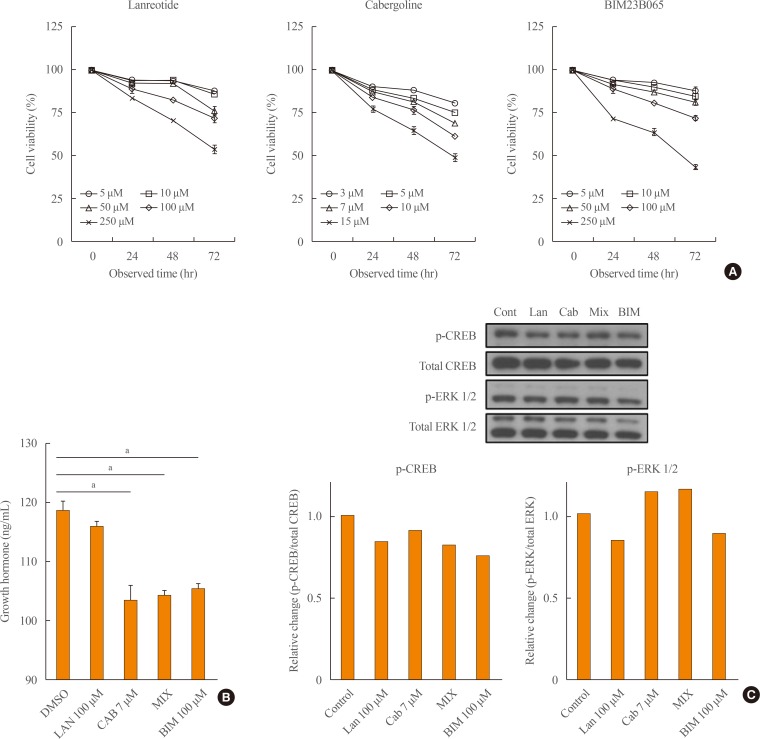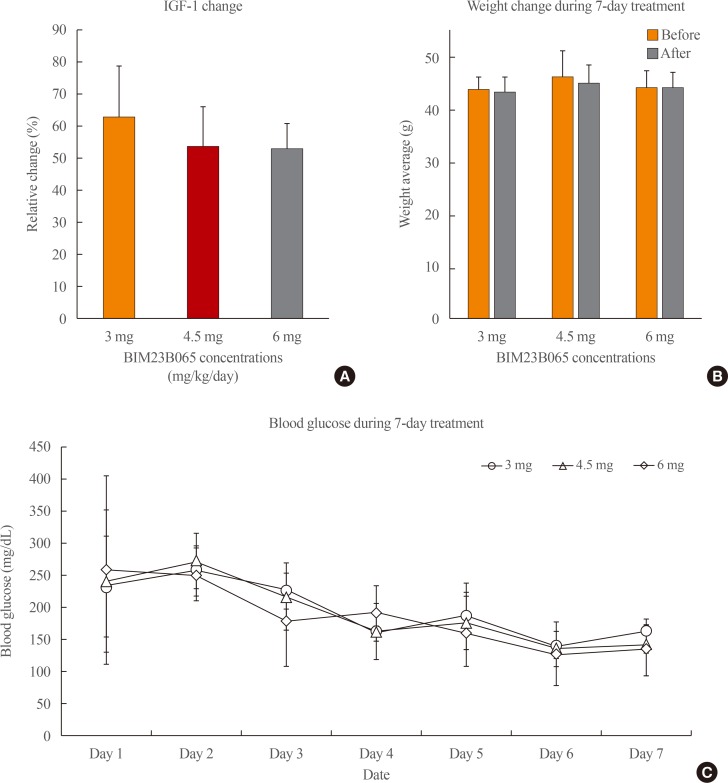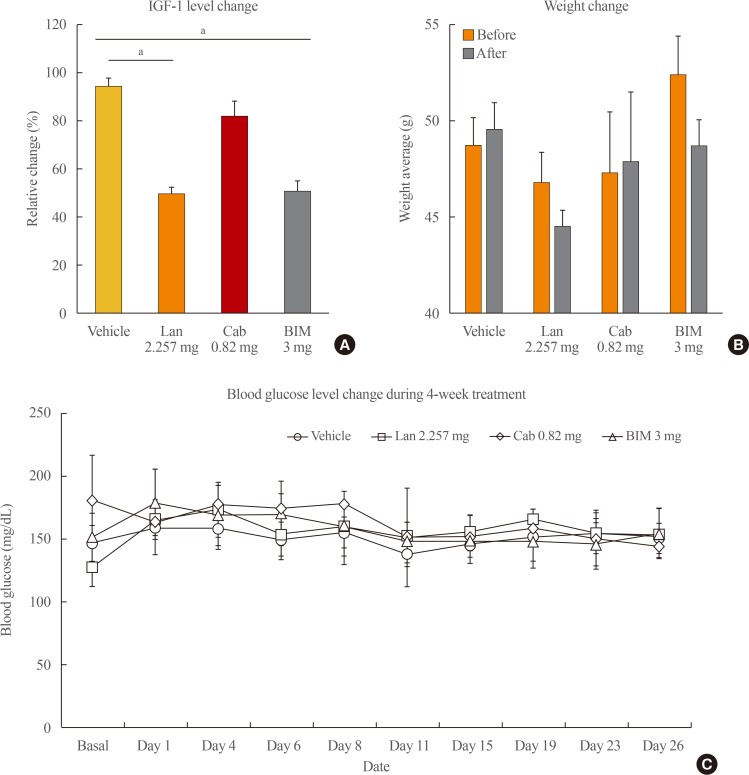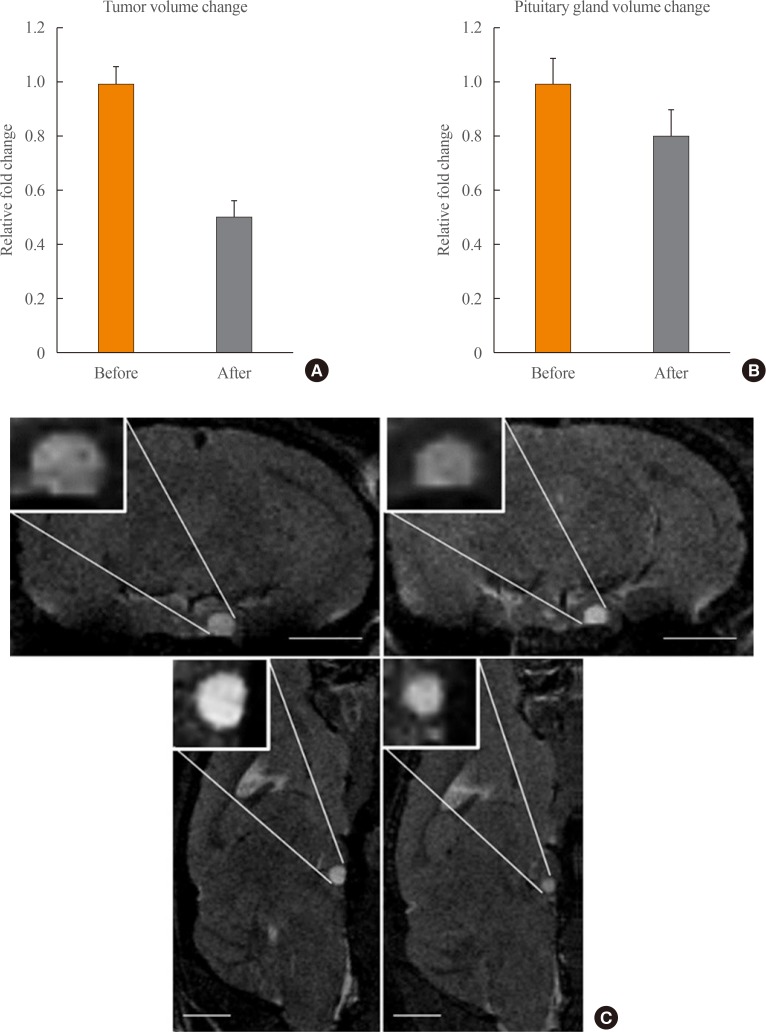Endocrinol Metab.
2020 Mar;35(1):177-187. 10.3803/EnM.2020.35.1.177.
Therapeutic Effect of a Novel Chimeric Molecule Targeting Both Somatostatin and Dopamine Receptors on Growth Hormone-Secreting Pituitary Adenomas
- Affiliations
-
- 1Brain Korea 21 PLUS Project for Medical Science, Yonsei University, Seoul, Korea. ejlee423@yuhs.ac
- 2Endocrinology, Institute of Endocrine Research, Yonsei University College of Medicine, Seoul, Korea. cr079@yuhs.ac
- 3Endocrinology Research, Ipsen Bioscience Inc., Cambridge, MA, USA.
- KMID: 2471734
- DOI: http://doi.org/10.3803/EnM.2020.35.1.177
Abstract
- BACKGROUND
Acromegaly is a rare disease primarily caused by growth hormone (GH)-secreting pituitary adenomas, and its treatment is costly. Moreover, some patients are unresponsive to treatment. Hence, there are increasing efforts to develop new drugs with improved effectiveness for this disease. BIM23B065 is a novel chimeric molecule that acts on both somatostatin and dopamine receptors. This study aimed to investigate the effects of BIM23B065 compared with those of a somatostatin receptor analog and a dopamine agonist.
METHODS
The effects of BIM23B065 on the proliferation, GH and insulin-like growth factor-1 (IGF-1) levels, and extracellular signal-regulated kinase (ERK) 1/2 and cyclic AMP response element binding (CREB) phosphorylation of GH3 cells were investigated with MTS assay, enzyme-linked immunosorbent assay, and Western blotting, respectively. The dosage and treatment duration of BIM23B065 were tested in animal models of GH-secreting pituitary adenoma. The effect of BIM23B065 (3 mg/kg/day) on changes in IGF-1 levels before and after treatment was further investigated.
RESULTS
In vitro, BIM23B065 treatment decreased GH release in the culture media and downregulated ERK 1/2 and CREB phosphorylation to 22% and 26%, respectively. In vivo, IGF-1 expression decreased to 50 % after 4 weeks of treatment with BIM23B065 using an osmotic pump implant. Moreover, magnetic resonance imaging results showed that the tumor size decreased significantly following treatment with BIM23B065 for 4 weeks.
CONCLUSION
The novel chimeric molecule was effective in decreasing IGF-1 and GH levels and may serve as an effective therapeutic agent for acromegaly.
MeSH Terms
-
Acromegaly
Blotting, Western
Culture Media
Cyclic AMP
Dopamine Agonists
Dopamine*
Enzyme-Linked Immunosorbent Assay
Growth Hormone
Growth Hormone-Secreting Pituitary Adenoma*
Humans
In Vitro Techniques
Insulin-Like Growth Factor I
Magnetic Resonance Imaging
Models, Animal
Phosphorylation
Phosphotransferases
Pituitary Neoplasms
Rare Diseases
Receptors, Dopamine*
Receptors, Somatostatin
Response Elements
Somatostatin*
Culture Media
Cyclic AMP
Dopamine
Dopamine Agonists
Growth Hormone
Insulin-Like Growth Factor I
Phosphotransferases
Receptors, Dopamine
Receptors, Somatostatin
Somatostatin
Figure
Reference
-
1. Katznelson L, Laws ER Jr, Melmed S, Molitch ME, Murad MH, Utz A, et al. Acromegaly: an endocrine society clinical practice guideline. J Clin Endocrinol Metab. 2014; 99:3933–3951. PMID: 25356808.
Article2. Melmed S, Colao A, Barkan A, Molitch M, Grossman AB, Kleinberg D, et al. Guidelines for acromegaly management: an update. J Clin Endocrinol Metab. 2009; 94:1509–1517. PMID: 19208732.
Article3. Chalabi M, Duluc C, Caron P, Vezzosi D, Guillermet-Guibert J, Pyronnet S, et al. Somatostatin analogs: does pharmacology impact antitumor efficacy? Trends Endocrinol Metab. 2014; 25:115–127. PMID: 24405892.
Article4. Srirajaskanthan R, Watkins J, Marelli L, Khan K, Caplin ME. Expression of somatostatin and dopamine 2 receptors in neuroendocrine tumours and the potential role for new biotherapies. Neuroendocrinology. 2009; 89:308–314. PMID: 19307732.
Article5. Gatto F, Hofland LJ. The role of somatostatin and dopamine D2 receptors in endocrine tumors. Endocr Relat Cancer. 2011; 18:R233–R251. PMID: 22135243.
Article6. Hofland LJ, Feelders RA, de Herder WW, Lamberts SW. Pituitary tumours: the sst/D2 receptors as molecular targets. Mol Cell Endocrinol. 2010; 326:89–98. PMID: 20438803.
Article7. Peverelli E, Giardino E, Treppiedi D, Meregalli M, Belicchi M, Vaira V, et al. Dopamine receptor type 2 (DRD2) and somatostatin receptor type 2 (SSTR2) agonists are effective in inhibiting proliferation of progenitor/stem-like cells isolated from nonfunctioning pituitary tumors. Int J Cancer. 2017; 140:1870–1880. PMID: 28120505.8. Gillam MP, Ku CR, Lee YJ, Kim J, Kim SH, Lee SJ, et al. Somatotroph-specific Aip-deficient mice display pretumorigenic alterations in cell-cycle signaling. J Endocr Soc. 2017; 1:78–95. PMID: 29264469.
Article9. Herman-Bonert VS, Zib K, Scarlett JA, Melmed S. Growth hormone receptor antagonist therapy in acromegalic patients resistant to somatostatin analogs. J Clin Endocrinol Metab. 2000; 85:2958–2961. PMID: 10946911.
Article10. Gruszka A, Culler MD, Melmed S. Somatostatin analogs and chimeric omatostatin-dopamine molecules differentially regulate human growth hormone and prolactin gene expression and secretion in vitro. Mol Cell Endocrinol. 2012; 362:104–109. PMID: 22705877.11. Ibanez-Costa A, Lopez-Sanchez LM, Gahete MD, Rivero-Cortes E, Vazquez-Borrego MC, Galvez MA, et al. BIM-23A760 influences key functional endpoints in pituitary adenomas and normal pituitaries: molecular mechanisms underlying the differential response in adenomas. Sci Rep. 2017; 7:42002. PMID: 28181484.
Article12. Peverelli E, Olgiati L, Locatelli M, Magni P, Fustini MF, Frank G, et al. The dopamine-somatostatin chimeric compound BIM-23A760 exerts antiproliferative and cytotoxic effects in human non-functioning pituitary tumors by activating ERK1/2 and p38 pathways. Cancer Lett. 2010; 288:170–176. PMID: 19619936.
Article13. Florio T, Barbieri F, Spaziante R, Zona G, Hofland LJ, van Koetsveld PM, et al. Efficacy of a dopamine-somatostatin chimeric molecule, BIM-23A760, in the control of cell growth from primary cultures of human non-functioning pituitary adenomas: a multi-center study. Endocr Relat Cancer. 2008; 15:583–596. PMID: 18509006.
Article14. Jaquet P, Gunz G, Saveanu A, Barlier A, Dufour H, Taylor J, et al. BIM-23A760, a chimeric molecule directed towards somatostatin and dopamine receptors, vs universal somatostatin receptors ligands in GH-secreting pituitary adenomas partial responders to octreotide. J Endocrinol Invest. 2005; 28(11 Suppl International):21–27. PMID: 16625841.15. Luque RM, Amargo G, Ishii S, Lobe C, Franks R, Kiyokawa H, et al. Reporter expression, induced by a growth hormone promoter-driven Cre recombinase (rGHp-Cre) transgene, questions the developmental relationship between somatotropes and lactotropes in the adult mouse pituitary gland. Endocrinology. 2007; 148:1946–1953. PMID: 17289844.
Article16. Su QQ, Xiang ZF, Qin J, Guo MF, Liu QS. Effects of cabergoline on the fertility of female mice during early and late pregnancy, and potential for its use in mouse control. Crop Prot. 2014; 56:69–73.
Article17. Koganemaru G, Abe H, Kuramashi A, Ebihara K, Matsuo H, Funahashi H, et al. Effects of cabergoline and rotigotine on tacrine-induced tremulous jaw movements in rats. Pharmacol Biochem Behav. 2014; 126:103–108. PMID: 25265240.
Article18. Zhou L, Liang X, Zhang L, Yang L, Nagao N, Wu H, et al. MiR-27a-3p functions as an oncogene in gastric cancer by targeting BTG2. Oncotarget. 2016; 7:51943–51954. PMID: 27409164.
Article19. Saveanu A, Lavaque E, Gunz G, Barlier A, Kim S, Taylor JE, et al. Demonstration of enhanced potency of a chimeric somatostatin-dopamine molecule, BIM-23A387, in suppressing growth hormone and prolactin secretion from human pituitary somatotroph adenoma cells. J Clin Endocrinol Metab. 2002; 87:5545–5552. PMID: 12466351.
Article
- Full Text Links
- Actions
-
Cited
- CITED
-
- Close
- Share
- Similar articles
-
- Clinical Characteristics and Treatments of Patients with TSH Secreting Pituitary Adenoma
- Microsurgical Transsphenoidal Approach for Pituitary Denomas
- Treatment Strategy of Growth Hormone Secreting Pituitary Adenoma
- Effects of Epidermal growth factor (EGF) on the suppression of GH3 cell growth
- The mechanism of Arginine-stimulated growth hormone secretion





